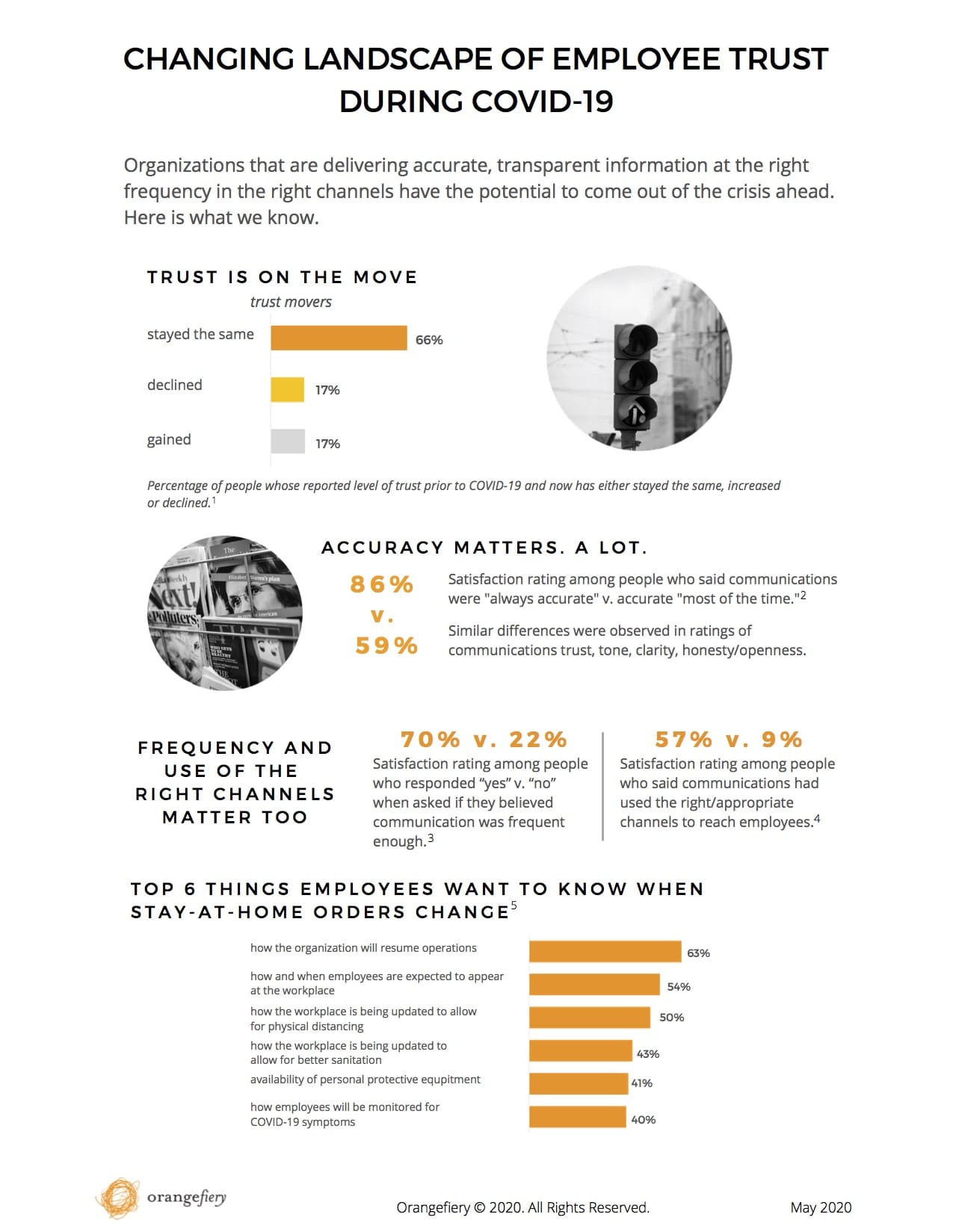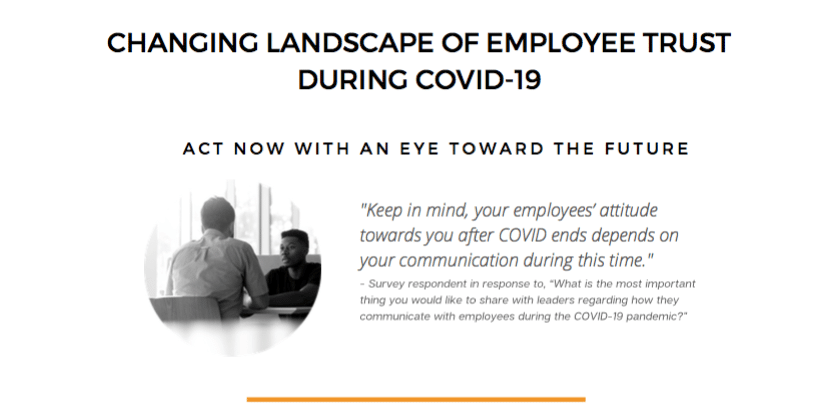New research shows that more than a third of U.S. employees say their level of trust in their organizations has changed during the COVID-19 pandemic, with equal levels reporting gains in trust (17 percent) as reductions in trust (17 percent) as the public health response to the novel coronavirus continues to impact organizations across the country.
The research from consulting and communications firm Orangefiery also illustrates the value of a high-performing communications function, with respondents who said they received communications that were “always” accurate, in the right channels, with the right tone and at the right frequency reporting significantly higher levels of trust than those who did not.
“This research shows that trust is very much in flux at this moment,” said Mike Kuczkowski, CEO of Orangefiery, in a news release. “Some organizations are improving their levels of trust with employees, while others are losing ground. Organizations that are delivering accurate, transparent communications at a reasonable frequency that address the questions on employees’ minds will come out of this crisis ahead. One of our survey respondents summarized it well: ‘Keep in mind, your employees’ attitude towards you after COVID ends depends on your communication during this time.’”
As stay-at-home orders begin to shift across the United States, 63 percent of respondents said they expect their organizations to share how they will prioritize employee safety. Respondents also want to know:
- How and when employees are expected to appear at the workplace (54 percent)
- How the workplace is being updated to allow for physical distancing (50 percent) and better sanitation (43 percent)
- Availability of personal protective equipment (41 percent)
- How employees will be monitored for COVID-19 symptoms (40 percent) and tested for COVID-19 infections (34 percent)
Of note, employees were more likely than leaders to say their organization was impacted by the public health response to COVID-19 (+8 percent) and more likely to expect their organizations to share information about how employees will be monitored for COVID-19 symptoms (+13 percent) and tested for COVID-19 infections (+11 percent).
Accuracy matters. A lot.
When asked whether communications were factually accurate, most respondents said “always” (41 percent) or “most of the time” (39%), while fewer said sometimes (15 percent), rarely (4 percent) or never (1 percent). Respondents who said communications were “always” accurate vs. accurate “most of the time” were significantly more likely to rate communications as being more satisfying, trustworthy, clear, and honest and open.
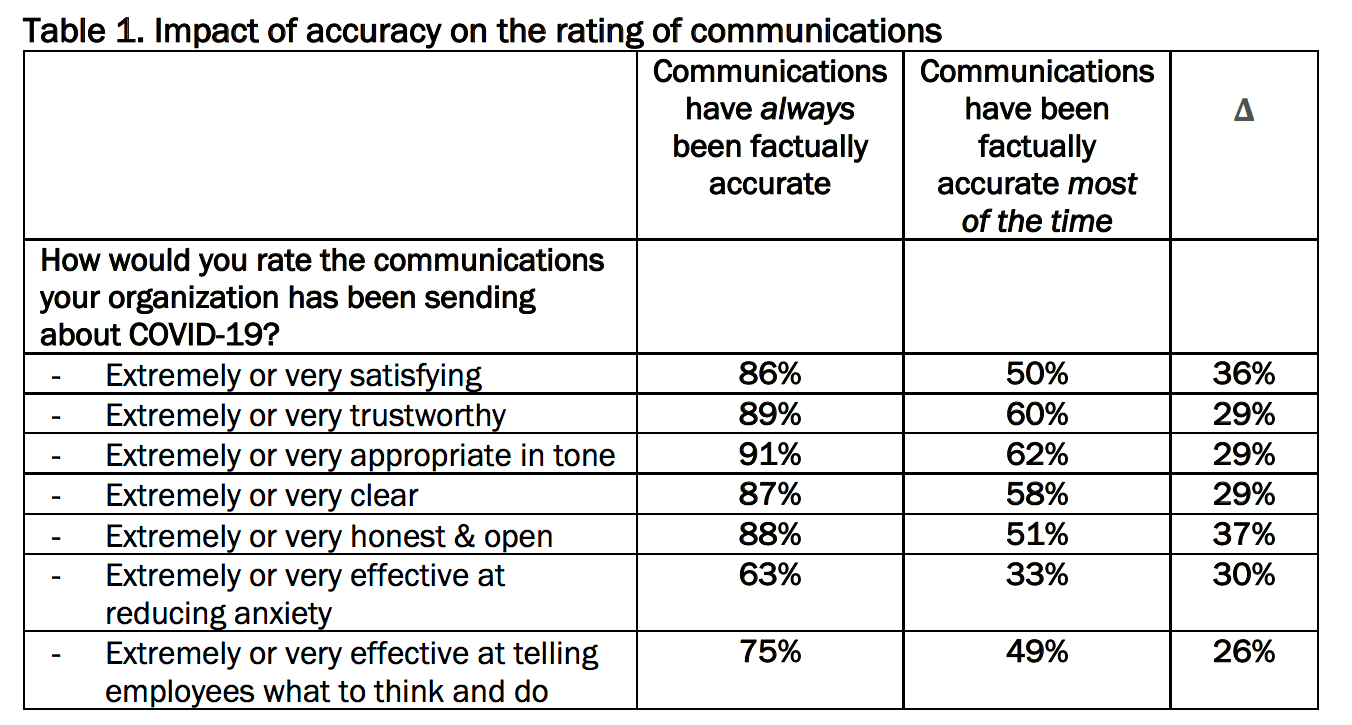
Respondents who said communications are “always” accurate vs. accurate “most of the time” also overwhelmingly trusted their organization before COVID-19 (85 percent vs. 46 percent) and were satisfied with the communications they received prior to COVID-19 (83 percent vs. 43 percent). They also continue to trust their organization to do the right thing now (88 percent vs. 48 percent) and are satisfied with the communications they are receiving from their organization about COVID-19 (86 percent vs. 50 percent). “Trust” in these comparisons represents respondents who said they trusted their organizations “very much” or “extremely” as opposed to “moderately,” “not very much” or “not at all.”
“What these results make clear is that every piece of communication to employees is important,” said Kuczkowski. “Taking the time to be accurate in each communication confers significant benefits in perceptions of trustworthiness, clarity of message and how satisfying employees find organizational communications to be overall. At the same time, slipping up on accuracy can have a significant negative impact.”
Using the right frequency and communications channels can also make a significant impact
Those who believe their organizations are communicating with them frequently enough (78%) are much more likely to rate the communications highly on important measures such as trustworthiness and clarity of message. Nearly all respondents said they are receiving at least weekly updates on COVID-19, with 23 percent saying they are receiving daily updates.
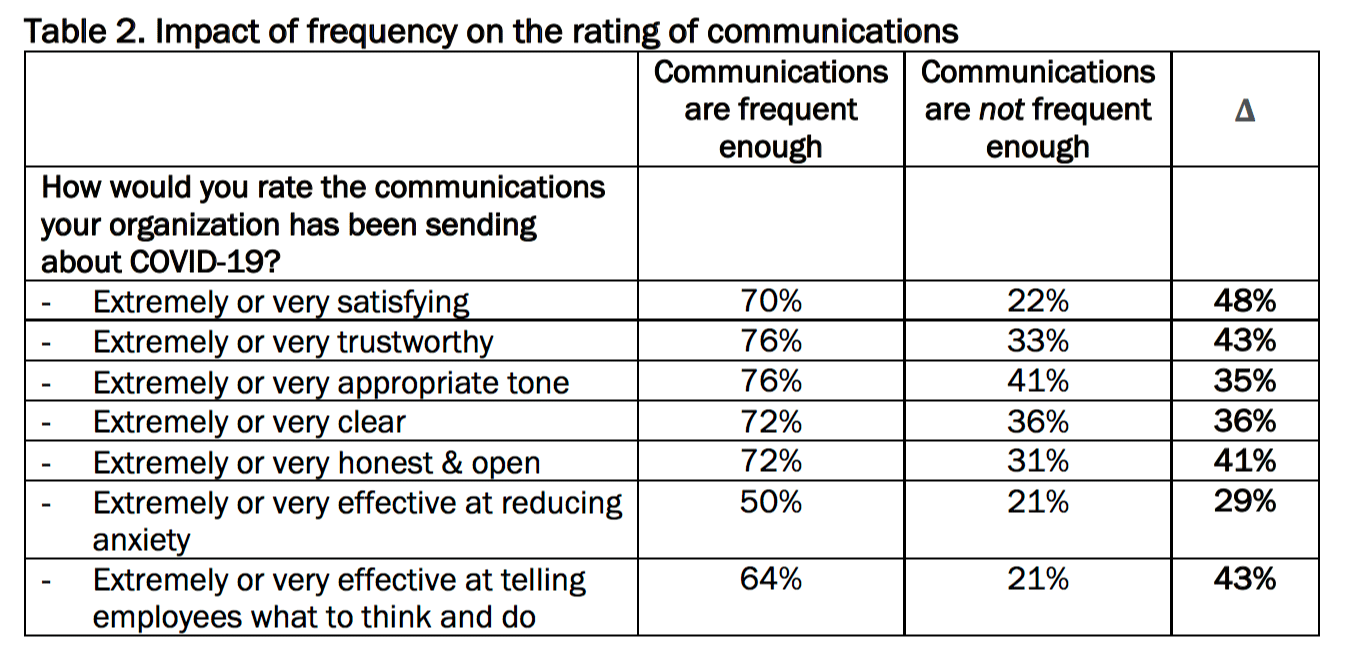
Those who believe their organization is communicating with them using the right channels (88 percent) are also more likely to rate the communications highly.
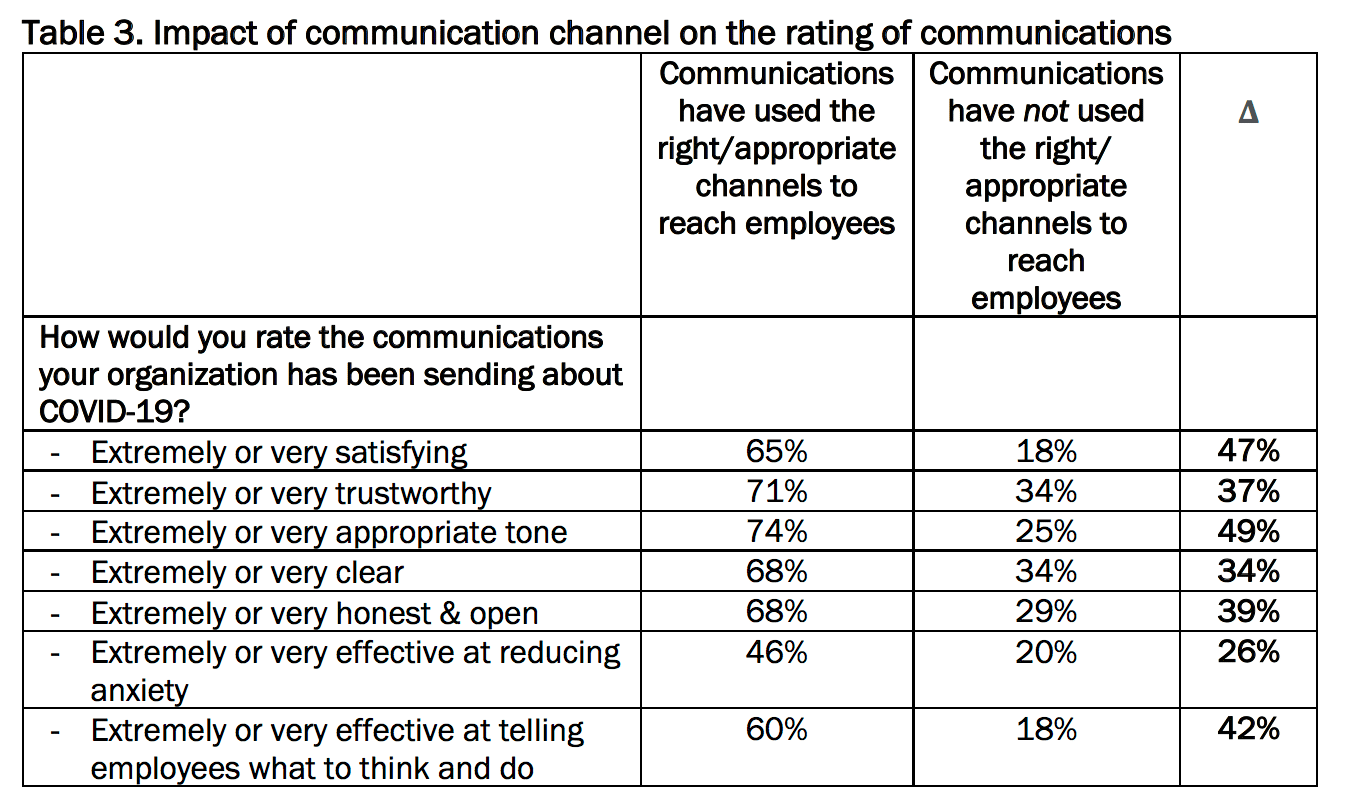
Communicating with the right frequency and using the right/appropriate channels correlated with positive outcomes around commitment and feedback.
Trust decliners and gainers
Fifty-nine percent of respondents said they trust their organization “very much” or “extremely” to do the right thing today, vs. 57 percent prior to the pandemic.
The 17 percent of survey respondents who reported declines in trust were more likely than average to say they worked at a small organization (+14 percent) and had experienced a decrease in activity (+6 percent) or a business/office closure (+7 percent). Overall, they rated communications less well than the average respondent on most measures of effectiveness, including trustworthiness (-25 percent), clarity (-25 percent), usefulness in telling employees what to think and do (-20 percent), honesty and openness (-18 percent), alleviating anxiety (-17 percent) and satisfaction (-16 percent). They also were less likely to say communications had been “always” accurate (-14 percent).
They also were more likely to say organizational communications had not been frequent enough (+16 percent), had not addressed the right topics (+13 percent), had not effectively addressed misinformation (+12 percent), that organizational leaders had not kept their promises around actions or communications (+14 percent) and were not as available as they should be to answer questions and discuss organizational needs (+10 percent). They were also more likely to ask that future communications provide greater transparency about what leaders know and don’t know (+15 percent), more information about plans to resume operations (+11 percent), be more frequent (+11 percent) and do more to directly acknowledge misinformation and/or rumors (+11 percent). In fact, of the 15 choices for what communications should “do more” of, trust decliners selected more choices than the average respondent, indicating a general need for more information of all types.
The 17 percent of respondents who reported gains in trust, by contrast, were more similar to the average respondent on most measures. They were more likely than average to say they worked for a medium-sized business and that they were in a leadership role. They were more likely to rate the impact of the coronavirus as “neutral” and less likely to say they had experienced a shift in work or remote work as a result of the pandemic.
Trust gainers were also more likely to say communications had been more frequent than usual, and more likely to say communications should discuss plans for reopening (+9 percent). Those who reported gains in trust had lower levels of trust than average prior to the pandemic, suggesting that their expectations for communications may have been low.
However, some significant gaps still exist. When asked how they would describe the communications their organization is distributing about COVID-19, respondents who identified as employees rated the communications better than leaders. Employees were more likely to say the communications:
- Are more frequent than usual (+29 percent)
- Have an appropriate tone (+17 percent)
- Use clear and consistent terminology (+12 percent)
- Have always been factually accurate (+12 percent)
- Acknowledge the difficulty of the situation (+11 percent)
Leader – employee gap
The March fielding of this survey revealed many gaps between how leaders and employees rated organizational communications about COVID-19. Many of these gaps—including in trust, honesty and openness, frequently and clearly indicating what leaders know and don’t know—narrowed or closed in the second fielding of this survey in April.
One exception is that employees were less likely than leaders to say communications have effectively addressed misinformation and/or rumors (-11 percent).
Meeting employee needs and listening to feedback
One major area of concern in the March 2020 fielding of this survey was how few respondents said their organization was committed to satisfying employee communications needs and interested in hearing employee feedback during the pandemic. Unfortunately, results did not improve in the April fielding. Only 52 percent said their organization is “very” or “extremely” committed to satisfying employee communications needs (vs. 57 percent in March). Only 49 percent said they believe their organization is “very” or “extremely” interested in hearing employee feedback (vs. 48 percent in March).
Grateful respondents
Despite many areas for improvement, some respondents are happy with their organizations’ leadership during COVID-19. In response to an open-ended question asking the most important thing they wanted to share with leaders, 40 of 230 respondents said they wanted to thank leaders and let them know they were doing a good job: “Just be honest, open, and try to do what’s best for everyone.” Thirty-nine respondents said they wanted leaders to prioritize health and safety. Another 36 urged leaders to provide clear, kind, honest, transparent and fact-based communications: “Just be honest, open, and try to do what’s best for everyone.”
Visit Orangefiery’s COVID-19 Resource Page here.
The research was conducted online on April 28, 2020, with a random sample of 469 U.S. employed adults aged 18-64. For results based on the total sample of employed national adults, the margin of error is +/-4.4% at a confidence level of 95. Of the 469 respondents, 319 identified as an “employee” and 133 identified as leaders, specifically “board member,” “member of the executive leadership team” or “member of the management team.” Seventeen identified as “other.” Respondents represented all regions of the United States and organizations of all sizes: 28% worked in organizations with 1-50 employees, 17% with 51-200 employees, 20% with 201-1,000 employees, 13% with 1,001-5,000 employees and 22% with 5,001+ employees. All respondents were required to be employed at the time they completed the survey.



